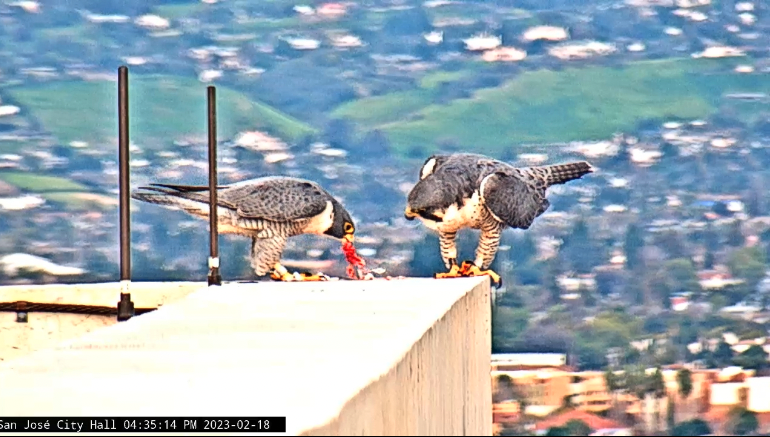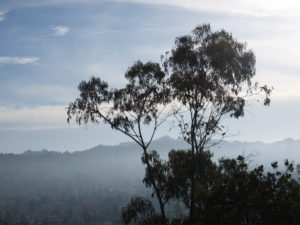Avian flu background
In the Winter 2023 print issue of Bay Nature, Guananí Gomez-Van Cortright traced the history of the latest avian pandemic, and what makes it so weird.
The Latest Bird Flu Pandemic Is Terrible—And Strange
Two of California’s most iconic endangered raptors have been hit by the devastating strain of avian influenza ravaging domestic and wild birds worldwide.
On Wednesday, the U.S. Fish and Wildlife Service announced that at least seven endangered California condors found dead in Arizona tested positive for avian influenza. The virus is suspected to have also killed 11 more area condors; test results are pending.
Meanwhile, Shasta, a female peregrine falcon nesting atop San Jose City Hall, was confirmed to have died from avian influenza in late March. Shasta was the mate of Sequoia, the offspring of the beloved UC Berkeley campanile falcons Annie and Grinnell.
“I’m concerned about all of our falcons,” says Zeka Glucs, director of the Predatory Bird Research Group at UC Santa Cruz. “All it takes is one infected meal. Peregrine falcons are, unfortunately, specialists in the species that are really good reservoirs for this virus.” That includes waterfowl and shorebirds, which falcons can pluck out of the air mid-flight.
There are currently an estimated 300 peregrine falcon mating pairs in California. A select few, including the UC Berkeley and San Jose falcons, have become social media stars via nest webcams. In March, viewers of the San Jose City Hall webcam alerted the Predatory Bird Research Group that Shasta was behaving oddly, bobbing her head and flying in a strange, uncoordinated way. Soon after, a passerby found her injured on a nearby sidewalk, and she was taken to the Silicon Valley Wildlife Center. She died the next day, and a necropsy test confirmed avian flu. Sequoia disappeared shortly after Shasta became ill, and has not been seen at the nest since. It was the falcon pair’s first year nesting together.
“They were ready to lay, before she got sick,” says Glucs. “It was heartbreaking, to watch her be sick, to be able to see her on cam and the distress she was in.”
In early March, a California condor in Arizona was found dead below her nest after showing signs of distress. At first, lead poisoning—the leading cause of death for wild condors—was suspected. A lab test revealed the condor was infected with the latest strain of avian flu, which produces similar neurological symptoms as lead poisoning.
“I’m very concerned, especially for the condors,” says Glucs. “Folks have done all they can to try to prepare for something like this, and really boosted the population in the wild. But at this point, it seems like maybe an inevitability that [more populations] will be exposed.”
In 1982, there were only 22 California condors left in the wild. Tremendous efforts have been spent on recovering the species. As of 2022, there were 561 California condors worldwide, with 347 of them flying in the wild, according to the National Park Service. There are five wild California condor flocks, concentrated in the Pacific Northwest, Central California, Southern California, Baja California, and Arizona/Utah. Now, the latest avian influenza may pose another major threat to their recovery.
“The California condor is a very iconic species, well known, well loved, well recognized across the country, and especially in the areas where we have populations,” says Joanna Gilkeson, spokesperson for the U.S. Fish and Wildlife Service. “We’re working with our partners to do everything we can to try to limit the spread of HPAI and help those birds currently affected.”
The latest strain of avian flu that has been sweeping the globe and more recently California is the deadliest and most infectious bird flu ever to strike North America, according to wildlife epidemiologists. The strain is known as Goose/Guangdong lineage highly pathogenic avian influenza, or Gs/GD HPAI.
As of February 2023, Gs/GD HPAI has been detected in wild birds in 47 out of 58 California counties, including all nine Bay Area counties, and has been found in every U.S state except Hawaii. The virus has ravaged domestic poultry flocks, and has sickened and killed more species of wild birds across a greater geographic area than any previous outbreak. As of this month, the virus has affected more than 52 million domestic poultry birds in the U.S. and has been detected in 6,542 wild birds across the country. This is likely a vast underestimate, since most sick birds are never tested.
Infected birds show telltale neurological symptoms like Shasta’s—swimming or walking in circles, seizures, head tics, or twisted necks. Once they’re showing symptoms, birds go down quickly. For raptors and poultry, the virus has a 90 to 100 percent fatality rate, and there is no treatment. Infected birds can shed the virus through bodily fluids or excretions, mainly feces, that end up in the water other birds use. Raptors and other scavenging species, including some mammals, can get sick from eating diseased carcasses. Waterfowl, seabirds, and raptors are highly susceptible, while songbirds account for only 2 percent of detections.
Wildlife epidemiologists expect that Gs/GD HPAI exposures are likely to increase during wild birds’ spring migration to northern breeding grounds.
What to do if you see a sick bird
If you see raptors, waterfowl or other wild birds showing signs of avian flu, report them to the California Department of Fish and Wildlife online or call the California Department of Food and Agriculture’s sick bird hotline at 866-922-BIRD (2473). Signs and symptoms include lack of coordination, twisted necks and head tics, walking in circles, and unusual numbers of dead birds in a single location. Do not touch or handle dead or ill wildlife.





